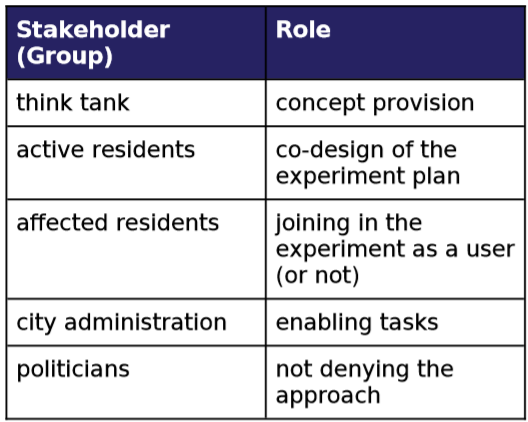Case Study on streets converting into seasonal socialising spaces
Title
Brief description
Living Streets is a series of real-life experiments whereby residents can temporarily turn their street into a place where people feel comfortable spending time once there are fewer cars and more social interaction. These experiments also help local administrations to ensure that new neighbourhoods are always designed to have ‘living streets’. The Living Streets were first developed in Ghent in 2012, as an experiment involving only two streets, but in 2021 it extended to over 25 residential roads across the city. Further European cities have successfully built on that experience together with their residents and stakeholders.
Keywords
place making; liveability; car-free cities; experiment; long-term change
City/Country
Time period
Recurring initiative (was or is still being repeated)
Lever(s)
Culture, civic participation & Social
Innovation
Methodologies
co-design, experimentation, place-making, nudging
World Region
Scale(s) of the case analysed
Target audience and dimension
Domain(s) of application
Context addressed
Solution applied
Challenge addressed/ Problem-led approach
Barriers addressed
Main Practices
Impact
Co benefits
Engagement Journey
Impact to climate neutrality
The contributions to climate change are indirect. First, by closing streets from cars and turning the streets into liveable places and nudges people to adopt more sustainable modes of mobility. Second, the experiments demonstrate that structural changes are possible and that resistance to change can be overcome one street after another. In Ghent, the Living Streets has been a part of a broader paradigm change in mobility planning, which has had a significant influence on the modal split: growing share of
cycling and public transport, reduction in car traffic.
Context & Public policy of reference
The city has been active in climate governance since 1996 as it joined the Climate Alliance, a network of European cities and municipalities to reduce greenhouse emissions. In 2007, the city council of Ghent took up the ambition to become
climate neutral by 2050. The mobility planning and the Living Streets initiative has to be
interpreted in this broader context.
Innovative approach(es) addressed
1. The residents were encouraged to work together to figure out what will work best. The experiments were about learning-by-doing and solving possible challenges that were encountered during the process.
2. The experiment gave an opportunity to see what life in the neighbourhood would be like without cars. The alternative forms of mobility got the upper hand at least temporarily and could thereby induce longer-term behavioural change.
3. The city council also supported the process by ensuring that the necessary permits and licenses were in place, and that necessary
materials are available.
Initiator
The concept was developed by a think tank and is nowadays promoted by a foundation. On each street, the residents developed the plans for their street and organised meetings to get buy-in from their neighbours. Once the municipality accepted the plan, residents got to implement the foreseen actions. During the implementation
phase, the residents were supported by the municipality.
Stakeholder networks and organisational model

Democratic Purpose
Participant Recruitment
nteraction between participants
Resources
Key enablers
There was the agreement that the city stands behind the initiative but that the actual interventions would have to be planned and
run by the residents after the city had admitted the bottom-up plan. The governance model could thus be described as facilitated self-organising where responsibility is shared.
Key inhibiting factors
The Living Streets stem partly from the frustration with fast car traffic through residential neighbourhoods. The citizens had addressed the city council without success.
Drawbacks/pros/cons of the solutions (after implementation)
1. It was somewhat difficult to deal with the cars that were banned during the experiment. However, many deliberately parked their cars out of easy reach, and did not miss their cars.
2. Some experiments were overly popular in the sense that there were complaints about the noises from the street. These were discussed openly in order to continue without creating dissonance locally.
Scalability
Key lessons
Living Streets proved that giving space for people rather than cars is an effective shortcut to liveable places. The collaborative approach to urban space reinforced social links by multiplying interactions among citizens. It also developed action networks of local stakeholders and citizens to capitalize the insights of the experiment more broadly in the local urban development. Ultimately, the experiment shall lead to support for more permanent car-free streets.
Indicators
Healthy Street indicators could be an option
External link
Cities of tomorrow infosheet on Living Streets
https://www.citiesoftomorrow.eu/sites/default/files/documents/Living
%20streets%20Ghent%20-%20BE.pdf
Digital memory aid international partner meeting, LIFE Living Streets-
project in Ghent, 2016
http://www.livingstreets.energy-cities.eu/IMG/pdf/memory_aid_living_street
-project_ghent.pdf
EnergyCities on EUKI Living Streets https://energy-cities.eu/project/euki-
living-streets-ghent/
EnergyCities on Living Streets https://energy-cities.eu/project/life-living-
streets/
Hölscher, K.; Chris Roorda & Frank Nevens (XXX). Ghent: Fostering a
Climate for Transition. In Loorbach. D. et al. (eds.) Governance of Urban
Sustainability Transitions, Theory and Practice of Urban Sustainability
Transitions. P. 91-112.
Lab van Troje (2012). De fiets van Troje.
https://issuu.com/defietsvantroje/docs/fiets_van_troje_web
Laurent, I. (2021). Three recommendations for translating Living Streets to
your city. Blog post https://www.eur.nl/en/media/2021-11-isa-laurent-
living-streets-blog
Leefstraat on Living Street https://www.leefstraat.be/the-ghent-
pioneering/
Living Streets - From citizen engagement to citizen ownership. Guidebook
by Meneer de Leeuw
https://issuu.com/meneerdeleeuw/docs/guidebook_livingstreet
McAskie, L. (2021).The Streets Are Alive In Ghent: It’s More Than Just
Removing Traffic, It’s Bringing People Together.
https://citychangers.org/the-streets-are-alive-in-ghent/
Nevens, Frank & Roorda, Chris. (2014). A climate of change: A transition
approach for climate neutrality in the city of Ghent (Belgium). Sustainable
Cities and Society 10, 112–121.
Peters, A. (2015). Belgian Streets Got Rid Of Cars And Turned Into
Beautiful Parks This Summer
Comments ()